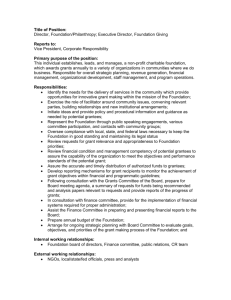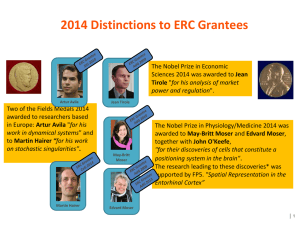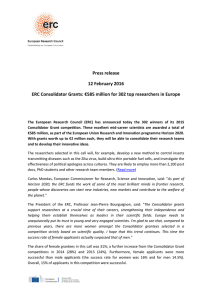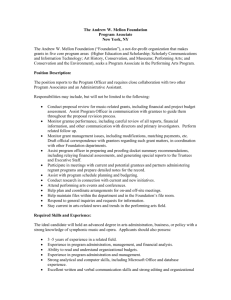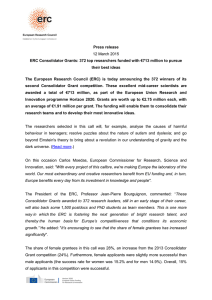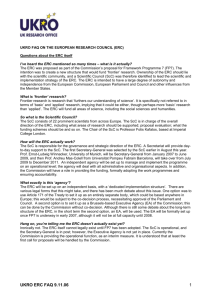ERC grants shaping research and academic careers
advertisement
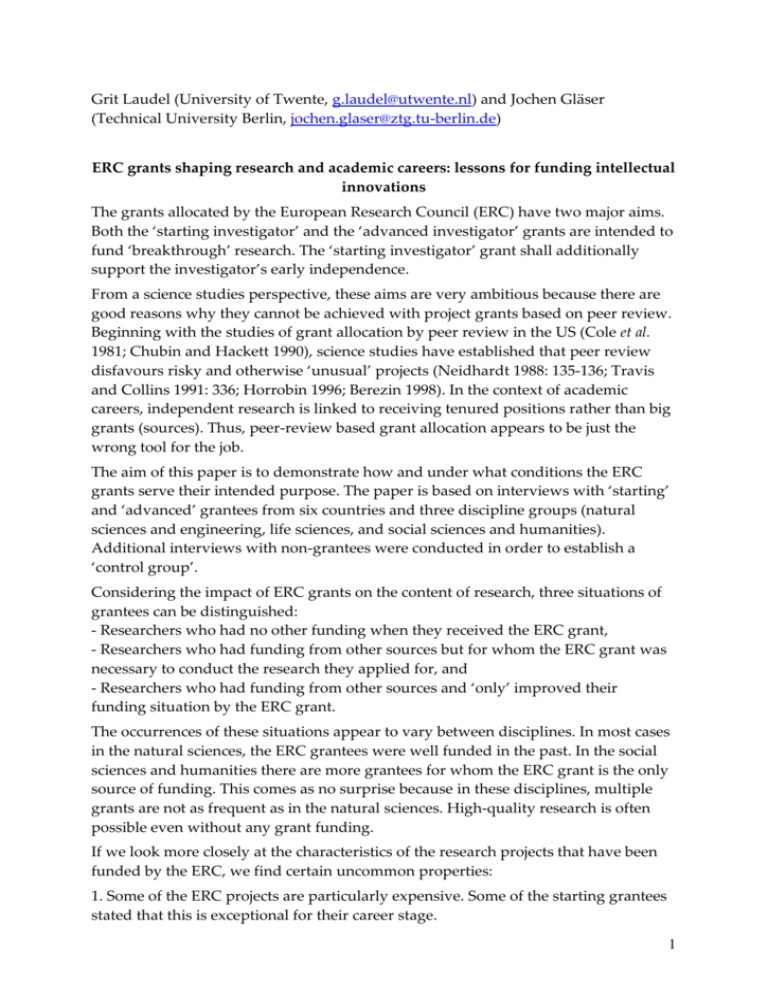
Grit Laudel (University of Twente, g.laudel@utwente.nl) and Jochen Gläser (Technical University Berlin, jochen.glaser@ztg.tu-berlin.de) ERC grants shaping research and academic careers: lessons for funding intellectual innovations The grants allocated by the European Research Council (ERC) have two major aims. Both the ‘starting investigator’ and the ‘advanced investigator’ grants are intended to fund ‘breakthrough’ research. The ‘starting investigator’ grant shall additionally support the investigator’s early independence. From a science studies perspective, these aims are very ambitious because there are good reasons why they cannot be achieved with project grants based on peer review. Beginning with the studies of grant allocation by peer review in the US (Cole et al. 1981; Chubin and Hackett 1990), science studies have established that peer review disfavours risky and otherwise ‘unusual’ projects (Neidhardt 1988: 135-136; Travis and Collins 1991: 336; Horrobin 1996; Berezin 1998). In the context of academic careers, independent research is linked to receiving tenured positions rather than big grants (sources). Thus, peer-review based grant allocation appears to be just the wrong tool for the job. The aim of this paper is to demonstrate how and under what conditions the ERC grants serve their intended purpose. The paper is based on interviews with ‘starting’ and ‘advanced’ grantees from six countries and three discipline groups (natural sciences and engineering, life sciences, and social sciences and humanities). Additional interviews with non-grantees were conducted in order to establish a ‘control group’. Considering the impact of ERC grants on the content of research, three situations of grantees can be distinguished: - Researchers who had no other funding when they received the ERC grant, - Researchers who had funding from other sources but for whom the ERC grant was necessary to conduct the research they applied for, and - Researchers who had funding from other sources and ‘only’ improved their funding situation by the ERC grant. The occurrences of these situations appear to vary between disciplines. In most cases in the natural sciences, the ERC grantees were well funded in the past. In the social sciences and humanities there are more grantees for whom the ERC grant is the only source of funding. This comes as no surprise because in these disciplines, multiple grants are not as frequent as in the natural sciences. High-quality research is often possible even without any grant funding. If we look more closely at the characteristics of the research projects that have been funded by the ERC, we find certain uncommon properties: 1. Some of the ERC projects are particularly expensive. Some of the starting grantees stated that this is exceptional for their career stage. 1 2. The duration of the grant enables long-term research, i.e. research that will not lead to publishable results within the usual time span for externally funded research (two to three years). 3. Several of the interviewed grantees had applied with projects which were at least in parts very risky. These parts of the projects were ‘backed’ by other, less risky parts. 4. Some projects clearly left the mainstream of the applicants’ communities’ research. The utilisation of these properties varies between countries and disciplines. The exceptional resources do not provide a particular advantage in the life sciences, while this advantage is pronounced in the physical sciences and visible in the social sciences and humanities. The five-year term of the grant is of importance to researchers across all disciplines and countries. The support of risky research is important for life science and physical science researchers, while researchers from all discipline groups benefit from the opportunity to conduct non-mainstream research. The most important effect on grantees’ organisational careers emerges from the grant’s prestige and portability, which make it possible for grantees to negotiate promotions or permanent positions. The effects for the advanced grantees are less clear. We find significant effects on research but - not surprisingly - little impact on the organisational career. These findings demonstrate that a) at least some of the ERC panels managed to overcome the traditional bias of peer reviews against risky and non-mainstream research, and b) that the specific conditions provided by the grants enable risktaking. Properties of grants that are of particular importance are the provision of flexible funding that violates ‘standards’ of disciplines (e.g. disproportionate amounts of funding for equipment in some of the natural sciences or funding for research groups in the humanities) and a duration of the funding that enables longer ‘publication-free’ periods in which an investigator can learn or develop new experiments. From this follows that national funding systems which don’t provide longer term funding either in the form of recurrent funding or in the form of longterm ‘big’ project grants suppress intellectual innovations. References: Berezin, A. (1998). "The Perils of Centralized Research Funding System." Knowledge, Technology & Policy 11: 5-26. Chubin, D. E. and E. J. Hackett (1990). Peerless Science: Peer Review and U.S. Science Policy. Albany, N.Y.: State University of New York Press. Cole, S., J. R. Cole and G. A. Simon (1981). "Chance and Consensus in Peer Review." Science 214: 881-886. Horrobin, D. F. (1996). "Peer review of grant applications: A harbinger for mediocrity in clinical research?" Lancet 348: 1293-1295. Neidhardt, F. (1988). Selbsteuerung in der Forschungsförderung. Opladen: Westdeutscher Verlag. 2 Travis, G. D. L. and H. M. Collins (1991). "New Light on Old Boys: Cognitive and Institutional Particularism in the Peer Review System." Science, Technology, & Human Values 16: 322-341. 3
